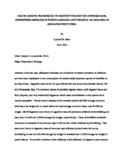USE OF GENETIC TECHNIQUES TO IDENTIFY THE DIET OF COWNOSE RAYS, RHINOPTERA BONASUS, IN NORTH CAROLINA AND VIRGINIA : AN ANALYSIS OF SHELLFISH PREY ITEMS
Author
Bade, Lyndell M.
Abstract
Cownose rays, Rhinoptera bonasus, are considered voracious predators on mollusks and have been implicated in the consumption of commercially important species of shellfish on the East Coast. Digestive tracts of the 32 rays collected for this study from Pamlico Sound, NC and Chesapeake Bay, VA contained pieces of partially-digested tissue, well-digested tissue and fluid (chyme), and very small shell fragments which made identification to the species level nearly impossible. Visual content analysis of the stomach yielded 80.78% average unknown total tissue by weight and in spiral valves the total average unknown tissue was 94.39% by weight. Shell fragments were found in digestive tracts of specimens collected by bowfishing and haul seine (4.54% and 3.02% averages by weight, respectively). Tissue identifiable as bivalve was found in stomachs from cownose rays (> 90 cm disc width) collected by bowfishing. Fish parts were found in digestive tracts of cownose rays collected by haul seine but not by bowfishing or cast net (10.24% average by weight in stomachs and 2.53% average by weight in spiral valves). To provide a solution to the difficulty of identification of digestive tract contents by visual methods, molecular identification techniques, using the sequence of the cytochrome oxidase subunit I (COI) gene, were applied to a variety of samples to determine the presence of key bivalve species of commercial and ecological importance in North Carolina and Chesapeake Bay. Species chosen were Atlantic bay scallop (Argopecten irradians concentricus), Baltic macoma clam (Macoma balthica), cross-barred venus clam (Chione cancellata), Eastern oyster (Crassostrea virginica), hard clam (Mercenaria mercenaria), soft shell clam (Mya arenaria), and stout tagelus clam (Tagelus plebieus). Species-specific primers were designed from the COI sequences for each bivalve species. Primers were designed to amplify polymerase chain reaction (PCR) products of differing sizes that were distinguishable from the other species of interest. Based on the primer design, multiplexing of several species in one reaction was possible, reducing testing time and cost. Results indicated that cownose rays in Chesapeake Bay ate stout tagelus clams and soft shell clams. Baltic macoma positives were most likely cross-amplification with stout tagelus DNA and further work is required to test for Baltic macoma clams without cross-amplification. There was no evidence of commercially important bivalves (hard clams, oysters, and bay scallops) being consumed by the rays in this study. Ontogenetic shifts in prey were difficult to determine based on uneven sample sizes, but large adult females (disc width over 90 cm) were found with a large proportion of stout tagelus clams in their digestive tracts. All young-of-year (YOY) individuals were male and caught in North Carolina. The sample size was small (n = 3) but the YOY individuals did not eat any of the species tested for in this study. Further sampling over an extended period of time and locations is required to confirm these results. Best-use practices of tissue extraction, manipulation, and handling techniques are discussed to help inform methodologies for forensic testing on marine species.
Date
2013
Citation:
APA:
Bade, Lyndell M..
(January 2013).
USE OF GENETIC TECHNIQUES TO IDENTIFY THE DIET OF COWNOSE RAYS, RHINOPTERA BONASUS, IN NORTH CAROLINA AND VIRGINIA : AN ANALYSIS OF SHELLFISH PREY ITEMS
(Master's Thesis, East Carolina University). Retrieved from the Scholarship.
(http://hdl.handle.net/10342/4190.)
MLA:
Bade, Lyndell M..
USE OF GENETIC TECHNIQUES TO IDENTIFY THE DIET OF COWNOSE RAYS, RHINOPTERA BONASUS, IN NORTH CAROLINA AND VIRGINIA : AN ANALYSIS OF SHELLFISH PREY ITEMS.
Master's Thesis. East Carolina University,
January 2013. The Scholarship.
http://hdl.handle.net/10342/4190.
April 24, 2024.
Chicago:
Bade, Lyndell M.,
“USE OF GENETIC TECHNIQUES TO IDENTIFY THE DIET OF COWNOSE RAYS, RHINOPTERA BONASUS, IN NORTH CAROLINA AND VIRGINIA : AN ANALYSIS OF SHELLFISH PREY ITEMS”
(Master's Thesis., East Carolina University,
January 2013).
AMA:
Bade, Lyndell M..
USE OF GENETIC TECHNIQUES TO IDENTIFY THE DIET OF COWNOSE RAYS, RHINOPTERA BONASUS, IN NORTH CAROLINA AND VIRGINIA : AN ANALYSIS OF SHELLFISH PREY ITEMS
[Master's Thesis]. Greenville, NC: East Carolina University;
January 2013.
Collections
Publisher
East Carolina University

